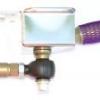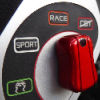Gaz, the whole subframe and diagonal support from the diagonal stays is not great. This was demonstrated to me when I lowered my engine in/out into the car, as the subframe visibly "sagged" by about 1" to 1.5". I was so shocked that I immediately checked for cracks in the subframe and checked the diagonal tubes + bolts to the roll hoop, but all seemed good.
In short I think the whole thing could be beefed up. God knows what all that sagging and rising must do to the geometry as the car weights/unweights during the course of normal driving.
I wish I'd taken a video of it when I was putting my engine in - it would startle most people I think.
Hi Nev
Yes it does bend but it has to! If it doesn't the peak G will be much higher and it will fatigue/fail much quicker.
I know it is tempting to remember the fully braced RXT turbo SD-4 GT from the magazine and thinking this must be the way to go....
If you want an empirical example of this simply punch your hand in front of you quite hard, now do it with your hand against a wall 
In the first case the forces were absorbed into the fingers and some of the energy was transferred through the wrist, then the arm, shoulder, eventually the whole body moved as well. In the second case the flesh of the fingers took all the energy from your fist and it probably hurt (assuming you were stupid enough not to know what would happen and did it anyway).
I don't want to spend too much time in discussion as the main aim is to collate so we can get a clearer picture of the failures.
It's probably easier to think of the subframe as a structured 3D spring rather than a rigid structure? for sure if you try to support any section of said spring then another part of the spring has to absorb the force instead, this is on top of the forces it was already dealing with and this usually results in a reduction in the time before the spring fatigues and fails.
it's very hard if not impossible to calculate where and for how long stresses are applied to certain sections without a full analysis so it's easier, cheaper, lighter and much safer to work around the problem rather than tackle it at the complex spring level. If we can reduce applying certain forces to the known weaker sections in the first place we can protect the subframe where it is weak and ensure it still acts as a spring everywhere else but if you attempt to do this with 2D or 3D stiffening close to the weak section you simply create new twists and bends around the section you are trying to protect.
It's fair to say Lotus put a lot of time and money into these structures so they have been very well analysed to a high level of competency and are not too far off optimum, the advances in tyres, regular track work and the high life cycle of a desirable car all negatively contribute as does the not ideal protection from the elements.
We plan to have a small amount of analysis done, mainly to confirm or reject some thoughts but first we really need as much info as possible to identify the patterns.
Thanks all

Gaz
![]()
![]()























